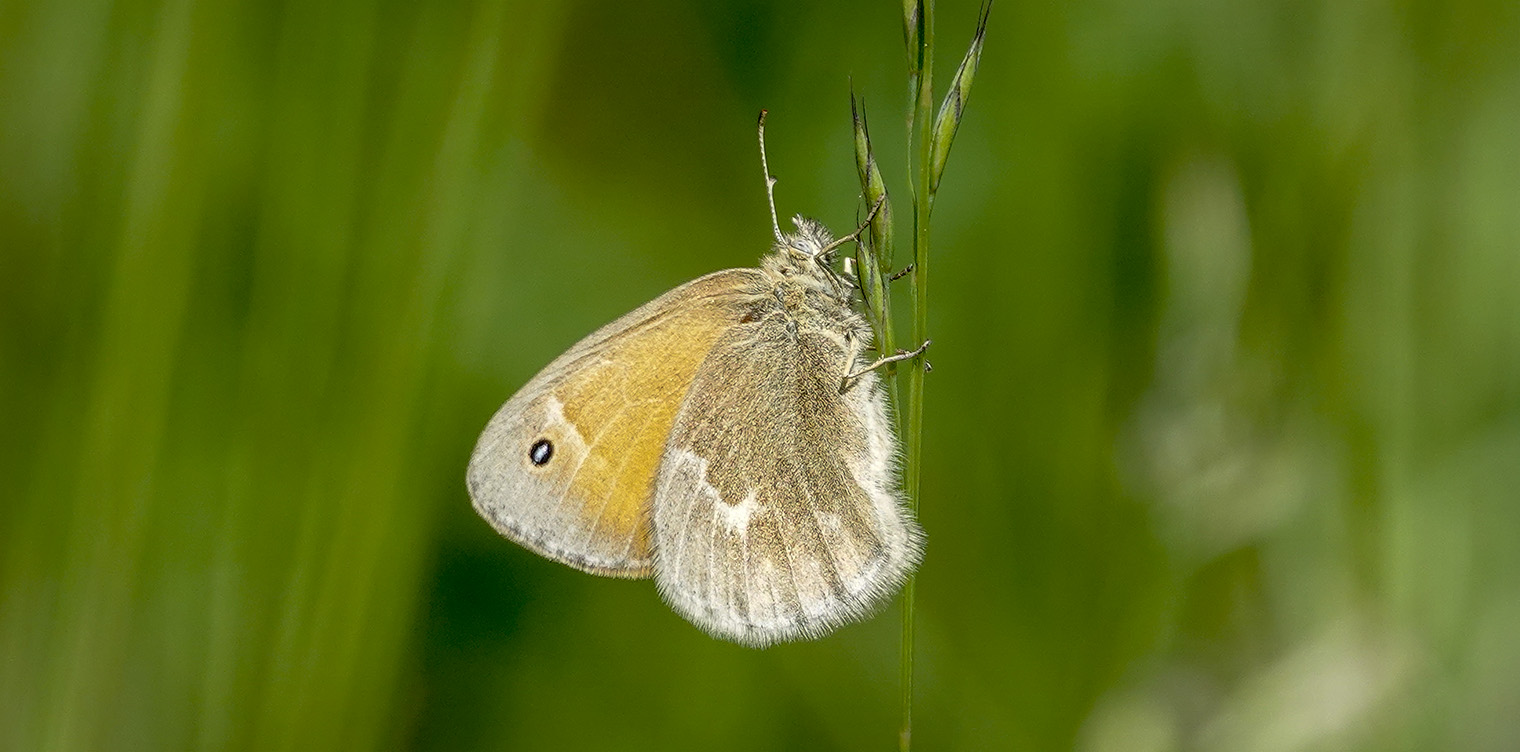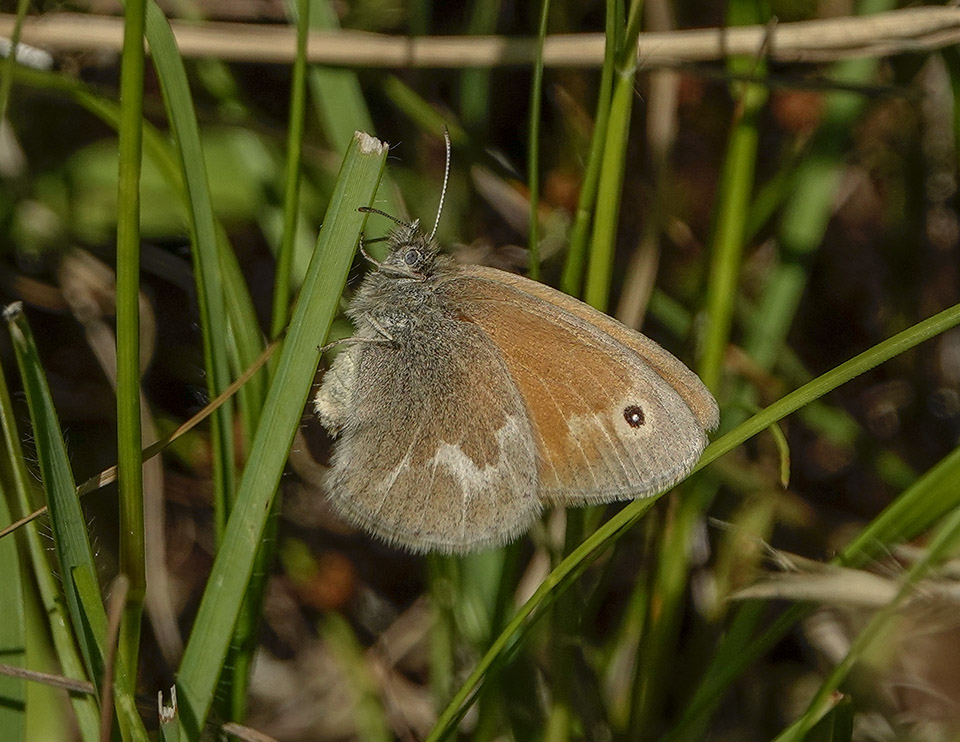Butterflies of the Adirondacks:
Common Ringlet (Coenonympha tullia)

The Common Ringlet (Coenonympha tullia) is an orange and brown butterfly that may be seen in the Adirondack Mountains of upstate New York from early to late summer.
The Common Ringlet is a member of the Nymphalidae family. This family (also known as brush-footed butterflies because the forelegs are small and hairy) is the largest family of butterflies and includes over 6,000 species throughout the world. Other members of this family found in the Adirondack region include White Admiral, Red Admiral, Atlantis Fritillary, Aphrodite Fritillary, Great Spangled Fritillary, Silver-bordered Fritillary, and Northern Crescent.
The Common Ringlet is a Satyr; it is a member of the subfamily Satyrinae (Satyrs and Wood-Nymphs). This subfamily includes about 50 species in North America. [1] The Satyrs are medium-sized butterflies, often brown with one or more eye spots; they which usually perch with their wings closed. [2] Other Satyrs found in the Adirondack Park include the Common Wood-Nymph, Eyed Brown, and Northern Pearly-eye.
Some sources, including iNaturalist, refer to this species as Coenonympha california, referencing a November 2020 study recommending this change based on genomic sequencing of butterflies. This change has yet to be adopted by Butterflies and Moths of North America or the Integrated Taxonomic Information System.
Common Ringlet: Identification

The appearance of this butterfly is extremely variable geographically. [3] [4] It is highly variable in both color and the number of eye spots, between and within subspecies and even within local populations. [5] [6] Up to 20 subspecies are recognized in North America. [7] [8]
The ringlets in our area (and in eastern Canada) are generally darker than those in the west; [9] they are usually a grayish brown with orange on the under side of the fore wing. [10] The hind wings are usually darker than the basal part of the fore wings. [11] The under side of the fore wing usually has a small eye spot. [12] [13] [14] The wing span is 1⅓ to 1½ inches. [15] [16]
Common Ringlet: Life History
Adult ringlets feed on flower nectar. These insects bounce through the grass, stopping frequently to nectar. [17] Male ringlets patrol above the tops of grasses to seek females. [18]
The larvae of Common Ringlets are green, olive or brown. [19] [20] Caterpillars hibernate in thick mats of dead grass. [21] [22] [23] Caterpillar hosts include grasses and rushes. [24] [25] [26]
Common Ringlet: Habitat and Range
Common Ringlets make their homes in a wide variety of grassy habitats, including fields, meadows, grasslands, roadsides, woodland edges and clearings, prairies, freshwater swamps, bogs, and tundra. [27] [28] [29]
Common Ringlets range throughout northern Europe and Asia. [30] They have extended their range significantly over the last few decades. [31] Their range now extends from coast to coast in Canada and the northern US. [32] [33] This butterfly is widespread and common in the west and north. [34] In the US, the Common Ringlet's range includes New England and the Adirondacks. [35]
Common Ringlet: Flight
The flight period for the Common Ringlet throughout its range is from May to July in the north and from May to September in the mid-latitudes. [36] [37] This species usually has one flight, with a partial second brood in the southern parts of its range. [38] [39]
The Common Ringlet's flight period in the Adirondack Park has not been established, but probably extends from mid-June through mid-September.
- This butterfly has been a fairly frequent guest in the Paul Smiths VIC Native Species Butterfly House in early summer. In 2012, The Common Ringlet was recorded as present from the day of the Butterfly House opening (9 June) to 22 June. [40] In 2013, Common Ringlets were present in the Butterfly House in the latter part of June. [41]
- In 2018, Common Ringlets were present in the meadow on the Potato Loop Trail at the John Brown Farm Trails in June, July, and mid-August. In 2019, Common Ringlets were flying at the John Brown Farm Trails in late August.
- Confirmed sightings reported for Adirondack Park counties in BAMONA suggest that Common Ringlets were on the wing in most years in late June through early September. [42]
- Observations reported on iNaturalist for most years range from mid-June through mid-September. [43]
References
- Susan Grimm Hanley. Interpretive Naturalist, Paul Smith's College Native Species Butterfly House. Species Logbooks.
- Butterflies and Moths of North America. Species Profiles. Common Ringlet. Coenonympha tullia. Retrieved 1 June 2022.
- Butterflies and Moths of North America. Common Ringlet. Coenonympha tullia. Confirmed sightings: 6/23/05, 6/23/06, 6/15/13, 6/25/13, 8/26/14, 8/27/14, 5/25/15, 8/15/15, 6/17/17, 6/17/17, 6/21/18, 7/2/18, 7/8/18, 7/13/18, 8/19/18, 8/31/18, 9/4/18, 6/15/19, 7/16/19, 8/13/19, 8/26/19, 6/21/20, 7/17/20, 8/21/20, 6/27/21. Retrieved 1 June 2022.
- Government of Canada. Canadian Biodiversity Information Facility. SpeciesBank. Retrieved 19 December 2019.
- Government of Canada. Canadian Biodiversity Information Facility. Taxonomic Index. Family Nymphalidae. Retrieved 19 December 2019.
- iNaturalist. Adirondack Park Sightings. Common Ringlet. Coenonympha tullia. Retrieved 22 November 2022.
- iNaturalist. Common Ringlet. Coenonympha california. Retrieved 1 June 2022.
- Integrated Taxonomic Information System. Coenonympha tullia. Common Ringlet. Retrieved 22 November 2022.
- Iowa State University. Department of Entomology. BugGuide. Common Ringlet. Coenonympha tullia. Retrieved 1 June 2022.
- Butterflies of America. Coenonympha tullia. Retrieved 1 June 2022.
- University of Alberta. Department of Biological Sciences. E.H. Strickland Entomological Museum. Coenonympha tullia. Retrieved 1 June 2022.
- Ross A. Layberry, Peter W. Hall, and J. Donald Lafontaine. The Butterflies of Canada (University of Toronto Press, 1998), pp. 215-216, Plate 18.
- Jim P. Brock and Kenn Kaufman. Kaufman Field Guide to Butterflies of North America (Houghton Mifflin, 2003), pp. 240-241.
- Paul A. Opler. A Field Guide to Eastern Butterflies (The Peterson Field Guide Series, Houghton Mifflin Company, 1992,1998), pp. 98-99, 303-304. Retrieved 1 June 2022.
- National Audubon Society. Field Guide to Butterflies (New York: Alfred A. Knopf, 1981), pp.662. Retrieved 10 December 2019.
- James A. Scott. The Butterflies of North America. A Natural History and Field Guide (Stanford University Press, 1986), pp. 239-240. Retrieved 1 June 2022.
- Jeffrey Glassberg. Butterflies through Binoculars. The East. A Field Guide to the Butterflies of Eastern North America (Oxford University Press, 1999), p. 138, Plate 44.
- Jeffrey Glassberg. Butterflies through Binoculars. A Field Guide to the Butterflies in the Boston-New York-Washington Region (Oxford University Press, 1993), pp. 67-68, Plate 23. Retrieved 1 June 2022.
